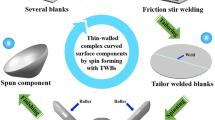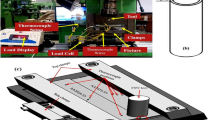Abstract
Employing friction stir welding (FSW) technology to join small plate blanks into larger ones, followed by a spinning process, adeptly surpasses the dimensional constraints of traditionally rolled plate blanks. This innovative approach paves the way for the fabrication of large and super-sized thin-walled rotary components, with significant implications in the aerospace sector. In this methodology, the number and layout of welds critically influence the precision of forming in spun workpieces, which could be pivotal in the success of spun tailor-welded blanks (TWBs). Consequently, dedicated experimental research into the spin forming of TWBs, varying in weld numbers and configurations, is essential. This investigation employed annealed 2195 Al–Li alloy plates as the material for experimentation. Four types of blanks with varying weld distributions and increasing weld numbers were designed, prepared through multiple FSW processes, followed by spinning. Comprehensive measurements of weld torsion angles, surface morphology, thickness variations, and forming accuracy of the workpieces post-spinning were conducted. The results show that with the increase of the number of welds, the weld torsion angle of the workpiece after spinning decreases. The spinning process can significantly reduce the surface morphology of the weld area. The thickness of the weld area is thinner than that of the non-weld area, and the superposition of the welds will aggravate the thickness reduction. In addition, the accuracy deviation of the workpiece mainly occurs in the initial and final stages of spinning forming. A negative accuracy deviation occurs at the beginning of the spinning, and a positive accuracy deviation is observed at the end of the spinning stage. In the spinning stage, the welding area appears slight bulge. As the number of welding seams increases, the accuracy of the workpiece decreases.















Similar content being viewed by others
References
Xing, L., Zhan, M., Gao, P. F., & Ma, F. (2018). A method for establishing a continuous constitutive model of welded metals. Materials Science and Engineering: A, 718, 228–240. https://doi.org/10.1016/j.msea.2018.01.062
Ma, F., Gao, P. F., Ma, P. Y., & Zhan, M. (2019). Power spinning of the curved head with tailor welded aluminum alloy blank: Deformation, microstructure, and property. Metals, 9(12), 1359. https://doi.org/10.3390/met9121359
Zhan, M., Wang, X. X., & Long, H. (2016). Mechanism of grain refinement of aluminium alloy in shear spinning under different deviation ratios. Materials and Design, 108, 207–216. https://doi.org/10.1016/j.matdes.2016.06.095
Xia, Q. X., Xiao, G. F., Long, H., Cheng, X. Q., & Sheng, X. F. (2014). A review of process advancement of novel metal spinning. International Journal of Machine Tools and Manufacture, 85, 100–121. https://doi.org/10.1016/j.ijmachtools.2014.05.005
Gan, T., Yu, Z. Q., Zhao, Y. X., Evsyukov, S. A., & Lai, X. M. (2018). Effects of backward path parameters on formability in conventional spinning of aluminum hemispherical parts. Transactions of Nonferrous Metals Society of China, 28, 328–339. https://doi.org/10.1016/S1003-6326(18)64666-7
Chaskis, S., Stachouli, E., Gavalas, E., Bouzouni, M., & Papaefthymiou, S. (2022). Microstructure, phase formation and heat-treating of novel cast Al–Mg–Zn–Cu–Si lightweight complex concentrated aluminum based alloy. Materials, 15(9), 3169. https://doi.org/10.3390/ma15093169
Gözde, A., Onur, A., & Bülent, B. (2021). Characterization of Al-7075/T651 alloy by RRA heat treatment and different pre-deformation effects. Transactions of the Indian Institute of Metals, 74(12), 3025–3033. https://doi.org/10.1007/s12666-021-02369-5
Gözde, A., Abbas, T. Ö., & Bülent, B. (2023). A survey of the effect of cryogenic treatment and natural ageing on structural changes and second-phase precipitation in Al–Zn–Mg–Cu alloy. Journal of Thermal Analysis and Calorimetry, 148, 10713–10725. https://doi.org/10.1007/s10973-023-12414-8
Gözde, A., & Bülent, B. (2022). Metallurgical characterization of natural aging effects on pre-deformed Al 7075/T651 alloy during retrogression and re-aging heat treatment. Kovove Materialy-Metallic Materials, 60, 209–222. https://doi.org/10.31577/km.2022.4.209
Zhang, J., Feng, X. S., Gao, J. S., Huang, H., Ma, Z. Q., & Guo, L. J. (2018). Effects of welding parameters and post-heat treatment on mechanical properties of friction stir welded AA2195-T8 Al–Li alloy. Journal of Materials Science and Technology, 34, 219–227. https://doi.org/10.1016/j.jmst.2017.11.033
Tao, Y., Zhang, Z., Xue, P., Ni, D. R., Xiao, B. L., & Ma, Z. Y. (2022). Effect of post weld artificial aging and water cooling on microstructure and mechanical properties of friction stir welded 2198-T8 Al–Li joints. Journal of Materials Science and Technology, 123, 92–112. https://doi.org/10.1016/j.jmst.2022.01.020
Amin, A., Behrouz, B., Mahmoud, A., Farzaneh, S., Seyyed, E. M., & Ahmad, O. M. (2021). A modified version of friction stirwelding process of aluminum alloys: Analyzing the thermal treatment and wear behavior. Proceedings of the Institution of Mechanical Engineers, Part L: Journal of Materials: Design and Applications, 30(1), 1–19. https://doi.org/10.1177/14644207211023987
Behrouz, B., Mahmoud, A., & Reza, H. (2020). Comparison of different welding methods on mechanical properties and formability behaviors of tailor welded blanks (TWB) made from AA6061 alloys. Proceedings of the Institution of Mechanical Engineers, Part C: Journal of Mechanical Engineering Science, 30(1), 1–13. https://doi.org/10.1177/0954406220952504
Mahmoud, A., Amin, A., Behrouz, B., Ahmad, O. M., Farzaneh, S., & Mostafa, D. (2021). Study on the effect of the welding environment on the dynamic recrystallization phenomenon and residual stresses during the friction stir welding process of aluminum alloy. Proceedings of the Institution of Mechanical Engineers, Part L: Journal of Materials: Design and Applications, 235(8), 1809–1826. https://doi.org/10.1177/14644207211025113
Hammood, A. S., Esmailzadeh, M., Hosseini, S. N., Karimi, S., Calliari, I., Pezzato, L., & Brittain, R. (2023). Effect of friction stir welding parameters on microstructure and corrosion behavior of 2101 duplex stainless steel in simulated body fluid. International Journal of Precision Engineering and Manufacturing-Green Technology, 10, 327–337. https://doi.org/10.1007/s40684-022-00440-0
Laska, A., Szkodo, M., Pawłowski, Ł, & Gajowiec, G. (2023). Corrosion properties of dissimilar AA6082/AA6060 friction stir welded butt joints in different NaCl concentrations. International Journal of Precision Engineering and Manufacturing-Green Technology, 10, 457–477. https://doi.org/10.1007/s40684-022-00441-z
Lin, Y. C., Chen, J. Y., He, D. G., & Li, X. H. (2020). MarginAl-restraint mandrel-free spinning process for thin-walled ellipsoidal heads. Advances in Manufacturing, 8, 189–203. https://doi.org/10.1007/s40436-020-00296-0
Yan, X. G., Zhan, M., Wang, Y., Gao, P. F., & Wang, Y. D. (2023). Criterion and processing-dependence of forming states in the die-less spinning of conical part. The International Journal of Advanced Manufacturing Technology, 125, 3037–3051. https://doi.org/10.1007/s00170-023-10867-7
Zhou, S. Y., Han, Z. R., Jia, Z., Liu, B. M., & Gong, X. (2023). Research on the wall thinning influencing factors in die-less spinning by hemisphere roller. The International Journal of Advanced Manufacturing Technology, 126, 2497–2508. https://doi.org/10.1007/s00170-023-11296-2
Izadpanah, S., & Amini, M. (2023). Application of computationally advanced 3D finite element simulation for stress and strain Analysis of single and multi-pass spinning processes with experimental validation. International Journal of Precision Engineering and Manufacturing, 24, 1335–1353. https://doi.org/10.1007/s12541-023-00821-8
Zhang, H. R., Zhan, M., Zheng, Z. B., & Li, R. (2022). Manufacture of thin-walled axisymmetric components by friction stir welding and spinning of Al–Li alloy. JOM Journal of the Minerals Metals and Materials Society, 74, 3248–3260. https://doi.org/10.1007/s11837-022-05394-x
Zhang, H. R., Zhan, M., Zheng, Z. B., & Li, R. (2021). A systematic study on the effects of process parameters on spinning of thin-walled curved surface parts with 2195 Al–Li alloy tailor welded blanks produced by FSW. Frontiers in Materials, 8, 809018. https://doi.org/10.3389/fmats.2021.809018
Zhang, H. R., Zhan, M., Zheng, F. B., Li, R., & Ma, F. (2022). Forming dependence on spin roller paths for thin-walled complex components from 2195 Al–Li alloy TWBs. The International Journal of Advanced Manufacturing Technology, 120, 3113–3122. https://doi.org/10.1007/s00170-022-08974-y
Lakshminarayanan, A. K., Malarvizhi, S., & Balasubramanian, V. (2012). Developing friction stir welding window for AA2219 aluminium alloy. Transactions of Nonferrous Metals Society of China, 21, 2339–2347. https://doi.org/10.1016/S1003-6326(11)61018-2
Moreira, P., Jesus, D. A., Figueiredo, D. M., Windisch, M., Sinnema, G., & Castro, D. P. (2012). Fatigue and fracture behaviour of friction stir welded aluminium–lithium 2195. Theoretical and Applied Fracture Mechanics, 60(1), 1–9. https://doi.org/10.1016/j.tafmec.2012.06.001
Mahmoud, A., Behrouz, B., Amin, A., & Ahmad, O. M. (2021). Different attempt to improve the formability of aluminum tailor welded blanks (TWB) produced by the FSW. International Journal of Material Forming, 14, 1189–1208. https://doi.org/10.1007/s12289-021-01632-w
Amin, A., Behrouz, B., Mahmoud, A., Amir, H. K., & Ahmad, O. M. (2021). Comparison of the weldability of AA6061-T6 joint under different friction stir welding conditions. Journal of Materials Engineering and Performance, 30, 1110–1127. https://doi.org/10.1007/s11665-020-05379-4
Acknowledgements
The National Natural Science Foundation of China (Grant No. 52301090); Shandong Province ZR2023QE275 provided research facilities for this work; Shandong Province 2019GGX102023 key research and development plan project.
Author information
Authors and Affiliations
Corresponding author
Additional information
Publisher's Note
Springer Nature remains neutral with regard to jurisdictional claims in published maps and institutional affiliations.
Rights and permissions
Springer Nature or its licensor (e.g. a society or other partner) holds exclusive rights to this article under a publishing agreement with the author(s) or other rightsholder(s); author self-archiving of the accepted manuscript version of this article is solely governed by the terms of such publishing agreement and applicable law.
About this article
Cite this article
Sun, S., Wang, J., Gao, B. et al. Influence of Friction Stir Weld Seam Distribution on Spun Formed Workpieces. Int. J. Precis. Eng. Manuf. (2024). https://doi.org/10.1007/s12541-024-00994-w
Received:
Revised:
Accepted:
Published:
DOI: https://doi.org/10.1007/s12541-024-00994-w




